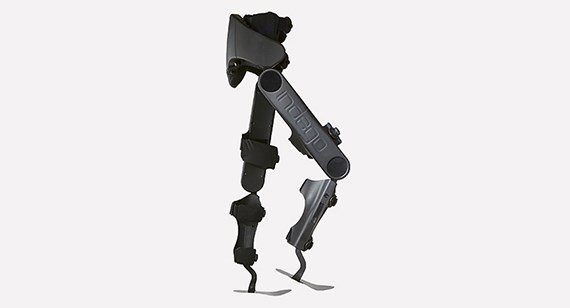Robotics Meets Digital Manufacturing

Parker Hannifin’s Indego robotic exoskeleton is designed to help users with lower limb paralysis walk again. During development, Parker Hannifin used Protolabs to test design iterations quickly. 3D printed Parker Hannifin Indego exoskeleton image courtesy of Protolabs, Inc.
Latest News
September 13, 2018
On-demand manufacturing is way better than Uber Eats, albeit their definitions of quick-turnaround have different connotations. Still, what do you have after your fast food delivery? Soiled shipping containers and some motley trash. On-demand manufacturing, on the other hand, can leave you with reduced development times, innovative products delivered to market faster and customers satisfied by your rapid response to their feedback.
The online case study “Parker Hannifin with Digital Manufacturing Brings Robotic Exoskeleton to Life” is a good example. It's all about speedy business-to-business collaboration, research and development. It begins with a technology licensing agreement to commercialize a robotic exoskeleton that enables people with lower limb paralysis to walk again. It ends with a fulfilled client sounding like they'll be back. In-between are fascinating techno tidbits and a close look at how digital manufacturing can transform design and development processes.
 Parker Hannifin's Indego robotic exoskeleton is designed to help users with lower limb paralysis walk again. During development, Parker Hannifin used Protolabs to test design iterations quickly. 3D printed Parker Hannifin Indego exoskeleton image courtesy of Protolabs, Inc.
Parker Hannifin's Indego robotic exoskeleton is designed to help users with lower limb paralysis walk again. During development, Parker Hannifin used Protolabs to test design iterations quickly. 3D printed Parker Hannifin Indego exoskeleton image courtesy of Protolabs, Inc.The robotic exoskeleton is named Indego. This wearable system is made up of hip and leg braces. Batteries power Indego's motors. It has a cluster of electronics. Intelligent software helps the user's movements.
The case study reports that traditional processes weren't going to meet tight deadlines. Essentially, waiting to get production quotes and final parts took too long. So the project team at Parker Hannifin’s Human Motion and Control business hooked up with Protolabs for fast prototypes, which they had done before, and, eventually, end-use parts.
Now, a tiny LED light pipe design to provide Indego users status details proved a challenge. The part was originally designed with a molded transparent thermoplastic. The material didn't play well with the rest of the assembly and was too brittle for daily use.
After some reevaluation, the team opted for liquid silicone rubber in part because of its flexibility and durability. Since Indego was still under development, they needed a cost-friendly molding option to quickly make components to test new designs.
Key was Protolabs' interactive quoting system. The team leveraged it frequently. What they'd do is upload designs, get design analysis feedback then revise designs until they hit their cost target. Everything happened digitally without making and waiting for a single part. Months of development time were saved.
“Parker Hannifin with Digital Manufacturing Brings Robotic Exoskeleton to Life” is a fast and savory read. It'll leave you with a lot to chew on as you approach your next development project and its tight deadlines. Hit the link and dig in.
Thanks, Pal. – Lockwood
Anthony J. Lockwood
Editor at Large, DE
Subscribe to our FREE magazine, FREE email newsletters or both!
Latest News
About the Author
Anthony J. Lockwood is Digital Engineering’s founding editor. He is now retired. Contact him via [email protected].
Follow DE







